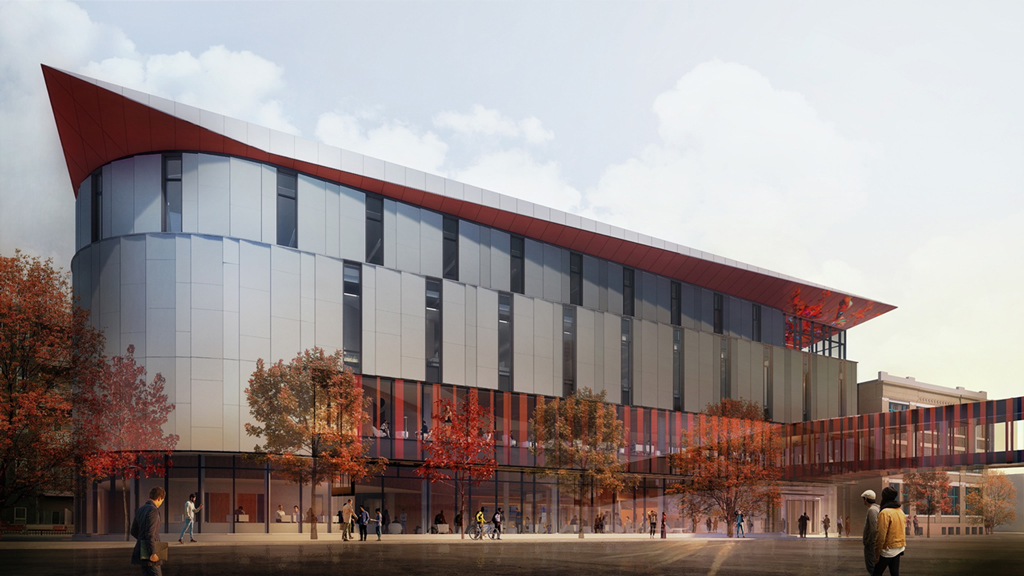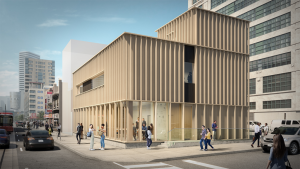RRC Polytech’s new innovation centre in downtown Winnipeg is the first building project in North America to integrate Kromatix Building Integrated Photovoltaics (BIPVs) into the construction of the facility.
“We’re proud to be the first institution in North America to welcome this sustainable technology. It’s only fitting that it’s installed on a building designed to cultivate and foster innovative ideas,” says Fred Meier, president of RRC Polytech, which was formerly known as Red River College, in a press release.
“This is just one example of how RRC puts its values of sustainability into action, and demonstrates to our students there is always a better way of doing things, so long as you are open to new ideas.”
“With this facility, we were trying to get as close to net-zero in terms of energy use as possible,” notes Maria Mendes, RRC Polytech senior project manager. “We were looking for the best way to use our roof surfacing to produce energy.”
Mendes credits the project’s architects, Diamond Schmitt Architects and Number TEN Architectural Group, for recommending BIPVs, an innovative product developed by SwissINSO to cover the solar panels that were to be installed along the innovation centre’s exterior façade.
Kromatix, she explains, is an opaque glass — colour-treated without the use of paint or tint — that is layered over the solar, thermal and electrical components of each panel. The technology results in esthetically impactful panels that are optimized for solar energy generation.
Electrical and building envelope crews installed approximately 400 of the units.
When combined with the building’s 138 rooftop panels, the glass will allow the college to offset energy consumption by about 193MW/year, enough to power 18.5 average-sized homes for the same amount of time.
The main challenge in choosing to utilize the Kromatix technology was having it certified according to Canadian standards, notes Frank Koreman, project manager at Akman Construction Ltd., the innovation centre’s lead contractor.
“Canadian certification standards are slightly different than those in Europe and the United States,” he points out. “We had to bring in an independent certification company (SolarLab) from Toronto. Each panel had to undergo a series of tests. Before installation, the panels had to meet the standards of, and be approved by, the Canadian Standards Association, the City of Winnipeg and Manitoba Hydro.”
He reports the RRC Polytech project team, along with Akman, Flynn Canada Inc. and Wescan Construction Services, worked with SolarLab in Denmark to learn and test the technology to determine how it could be adapted for Winnipeg’s weather systems.
SolarLab was also on hand virtually to provide guidance and help resolve any hiccups while crews installed the panels.
“The panels also act as cladding and a rains screen,” he points out. “The panels are unique in that they provide an architectural finish, but there are a lot of layers that need to work together.
“When we started, because this is one of the first in North America with this type of modules, there were no other reference points in terms of building codes and electrical codes to go along with installation. We can now look to this building as a reference point for the future.”
He adds, “it was really important for us to work with local tradespeople for the installation of the panels. Working with local trades to learn and install the panels means we have the technology here in Winnipeg, and it can be passed along and shared for future projects.
“The teams working on this project are loaded with RRC grads, so it comes full-circle to have been taught in school and then bring back new technology for an RRC project.”
Mendes points out the Kromatix BIPVs are just one of the sustainable features of the new 100,000-square-foot space. Other energy efficient technologies, including Power Over Ethernet lighting, smart LSI breakers and WiFi outlets, will all play a role in helping the building reach near net-zero and LEED Gold certification.
Once the building is complete, students in RRC’s trades programs will be able to use the innovation centre as a living lab, measuring energy consumption and generation levels for electricity, heating, cooling, lighting and more.











Recent Comments
comments for this post are closed